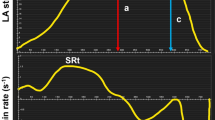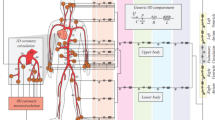Abstract
Arterial hypertension (HTN) represents one of the major causes of atrial fibrillation, a cardiac arrhythmia with high prevalence and comorbidity. The aim of this study was to investigate whether paroxysmal atrial fibrillation can be treated by the regression of left ventricular hypertrophy achieved by antihypertensive therapy. Included in the present study were 104 patients who had had HTN for more than 1 year. None of them suffered from coronary heart disease. All patients were investigated by 24-h Holter ECG and echocardiography at baseline and after a mean of 24 months. Patients were divided into two groups: group A consisted of those (53.8%) who showed a regression of the left ventricular muscle mass index (LVMMI) during the follow-up (154.9±5.1 vs. 123.5±2.8 g/m2), and group B those (45.2%) who showed a progression of LVMMI (122.2±3.2 vs. 143.2±3.2 g/m2). In group A the prevalence of atrial fibrillation decreased from 12.5% to 1.8% (p<0.05), while it was increased in group B from 8.5% to 17.0%. The left atrial diameter was reduced following antihypertensive therapy in group A from 39.1±5.3 mm to 37.4±4.6 mm (p<0.01) and increased in group B from 37.0±0.7 mm to 39.0±0.9 mm (p<0.01). We conclude that a regression of the left ventricular muscle mass leads to a reduction of left atrial diameter and consecutively to a decrease in the prevalence of intermittent atrial fibrillation. This may be explained by a better left ventricular diastolic function following decreased vascular and extravascular resistance of the coronary arteries. This relation shows the benefits of causal antihypertensive therapy for the treatment of paroxysmal atrial fibrillation.
Similar content being viewed by others
Article PDF
References
Evers S, Hennersdorf M, Perings C, Strauer BE : The epidemiology and causes of atrial fibrillation. Herzschr Electrophysiol 2001; 12: 59–67.
Kannel WB, Abbott RD, Savage DD : Coronary heart disease and atrial fibrillation: the Framinham Study. Am Heart J 1983; 106: 389–396.
Lip GYH, Hee LS : Paroxysmal atrial fibrillation. Q J Med 2001; 94: 665–678.
Benjamin EJ, Levy D, Vaziri SM, D'Agostino RB, Belanger AJ, Wolf PA : Independent risk factors for atrial fibrillation in a population-based cohort. The Framingham Heart Study. JAMA 1994; 271: 840–844.
Petersen P, Godfresen J : Embolic complications in paroxysmal atrial fibrillation. Stroke 1984; 17: 622–625.
Hennersdorf MG, Perings C, Kelm M, Strauer BE : Atrial fibrillation. Internist (Berl) 2001; 42: 1631–1640.
Pedersen OD, Bagger H, Kober L, Torp-Pedersen C, on behalf of the TRACE Study Group: Trandolapril reduces the incidence of atrial fibrillation after acute myocardial infarction in patients with left ventricular dysfunction. Circulation 1999; 100: 376–380.
Schwartzkopff B, Brehm M, Mundhenke M, Strauer BE : Repair of coronary arterioles after treatment with perindopril in hypertensive heart disease. Hypertension 2000; 36: 220–225.
Schmieder RE, Martus P, Klingbeil A : Reversal of left ventricular hypertrophy in essential hypertension. A meta-analysis of randomized double-blind studies. JAMA 1996; 275: 1507–1513.
Klingbeil AU, Schneider M, Martus P, Messerli FH, Schmieder RE : A meta-analysis of the effects of treatment on left ventricular mass in essential hypertension. Am J Med 2003; 115: 41–46.
Vogt M, Kreutz KU, Motz W, Strauer BE : Regression of hypertrophy following nitrendipine: effect on systolic and diastolic function. Z Kardiol 1989; 78: 469–477.
Mandinov L, Eberli FR, Seiler C, Hess OM : Diastolic heart failure. Cardiovasc Res 2000; 45: 813–825.
Motz W, Strauer BE : Improvement of coronary flow reserve after long-term therapy with enalapril. Hypertension 1996; 27: 1031–1038.
Strauer BE, Schwartzkopff B, Kelm M : Assessing the coronary circulation in hypertension. J Hypertens 1998; 16: 1221–1233.
Gottdiener JS, Reda DJ, Williams DW, Materson BJ, Cushman W, Anderson WJ, for the VA Cooperative Group on Antihypertensive Agents: Effect of single-drug therapy on reduction of left atrial size in mild to moderate hypertension. Circulation 1998; 98: 140–148.
Wachtell K, Lehto M, Gerdts E, et al: Angiotensin II receptor blockade reduces new-onset atrial fibrillation and subsequent stroke compared to atenolol: the Losartan Intervention for End Point Reduction in Hypertension (LIFE) study. J Am Coll Cardiol 2005; 45: 712–719.
Devereux RB, Reichek N : Echocardiographic determination of left ventricular mass in man. Anatomic validation of the method. Circulation 1977; 55: 613–618.
Koren MJ, Devereux RB, Casale PN, Savage DD, Laragh JH : Relation of left-ventricular mass and geometry to morbidity and mortality in uncomplicated essential-hypertension. Ann Intern Med 1991; 114: 345–352.
Fuster V, Ryden LE, Cannom DS, et al: ACC/AHA/ESC 2006 guidelines for the management of patients with atrial fibrillation-executive summary: a report of the American College of Cardiology/American Heart Association Task Force on practice guidelines and the European Society of Cardiology Committee for Practice Guidelines (Writing Committee to Revise the 2001 Guidelines for the Management of Patients with Atrial Fibrillation). Eur Heart J 2006; 27: 1979–2030.
Messerli FH, Nunez BD, Nunez MM, Garavaglia GE, Schmieder RE, Ventura HO : Hypertension and sudden death. Disparate effects of calcium entry blocker and diuretic therapy on cardiac dysrhythmias. Arch Intern Med 1989; 149: 1263–1267.
Schannwell CM, Schoebel FC, Badiian M, et al: Diastolic function parameters and atrial arrhythmias in patients with arterial hypertension. Dtsch Med Wochenschr 1998; 123: 957–964.
Verdecchia P, Reboldi G, Gattobigio R, et al: Atrial fibrillation in hypertension: predictors and outcome. Hypertension 2003; 41: 218–223.
Strauer BE : Hypertensive Heart Disease, 3rd ed. Berlin, Heidelberg, New York, and Tokyo, Springer, 1991.
Strauer BE : The significance of coronary reserve in clinical heart disease. J Am Coll Cardiol 1990; 15: 775–783.
Kelm M, Strauer BE : Coronary flow reserve measurements in hypertension. Med Clin North Am 2004; 88: 99–113.
Strauer BE : Ventricular function and coronary hemodynamics in hypertensive heart disease. Am J Cardiol 1979; 44: 999–1006.
Schwartzkopff B, Motz W, Frenzel H, Vogt M, Knauer S, Strauer BE : Structural and functional alterations of the intramyocardial coronary arterioles in patients with arterial hypertension. Circulation 1993; 88: 993–1003.
Assayag P, Carré F, Chevalier B, Delcayre C, Mansier P, Swynghedauw B : Compensated cardiac hypertrophy: arrhythmogenicity and the new myocardial phenotype. I. fibrosis. Cardiovasc Res 1997; 34: 439–444.
Hennersdorf MG, Hafke G, Steiner S, et al: Determinants of paroxysmal atrial fibrillation in patients with aterial hypertension. Z Kardiol 2003; 92: 370–376.
Frohlich ED : Clinical-physiologic classification of hypertensive heart disease in essential hypertension. in Moyer JH ( ed): Hypertension: Mechanisms and Management, 3rd ed. New York, Grune & Stratton, 1973, pp 181–190.
Gerdts E, Oikarinen L, Palmieri V, et al: Correlates of left atrial size in hypertensive patients with left ventricular hypertrophy. Hypertension 2002; 39: 739–743.
Dittrich HC, Pearce LA, Asinger RW, et al, on behalf of the Stroke Prevention in Atrial Fibrillation (SPAF) Investigators : Left atrial diameter in nonvalvular atrial fibrillation: an echocardiographic study. Am Heart J 1999; 137: 494–499.
Aronow WS, Ahn C, Kronzon I, Gutstein H : Association of left ventricular hypertrophy and chronic atrial fibrillation with the incidence of new thromboembolic stroke in 2,384 older persons. Am J Cardiol 1999; 84: 468–469.
Devereux RB, Palmieri V, Liu JE, et al: Progressive hypertrophy regression with sustained pressure reduction in hypertension: the Losartan Intervention for Endpoint Reduction study. J Hypertens 2002; 20: 1445–1450.
Hansson L, Zanchetti A, Carruthers SG, et al, HOT Study Group: Effects of intensive blood-pressure lowering and low-dose aspirin in patients with hypertension: principal results of the Hypertension Optimal Treatment (HOT) randomised trial. Lancet 1998; 351: 1755–1762.
Manolis AJ, Beldekos D, Handanis S, et al: Comparison of spirapril, isradipine, or combination in hypertensive patients with left ventricular hypertrophy. Effects on LVH regression and arrhythmogenic propensity. Am J Hypertens 1998; 11: 640–648.
Kelm M, Schafer S, Mingers S, et al: Left ventricular mass is linked to cardiac noradrenaline in normotensive and hypertensive patients. J Hypertens 1996; 14: 1357–1364.
Sonoyama K, Igawa O, Miake J, et al: Effects of angiotensin II on the action potential durations of atrial myocytes in hypertensive rats. Hypertens Res 2005; 28: 173–179.
Goette A, Arndt M, Rocken C, et al: Regulation of angiotensin II receptor subtypes during atrial fibrillation in humans. Circulation 2000; 101: 2678–2681.
Asai T, Kushiro T, Fujita H, Kanmatsuse K : Different effects on inhibition of cardiac hypertrophy in spontaneously hypertensive rats by monotherapy and combination therapy of adrenergic receptor antagonists and/or the angiotensin II type 1 receptor blocker under comparable blood pressure reduction. Hypertens Res 2005; 28: 79–87.
Okazaki H, Minamino T, Tsukamoto O, et al: Angiotensin II type 1 receptor blocker prevents atrial structural remodeling in rats with hypertension induced by chronic nitric oxide inhibition. Hypertens Res 2006; 29: 277–284.
Madrid AH, Bueno MG, Rebollo JM, et al: Use of irbesartan to maintain sinus rhythm in patients with long-lasting persistent atrial fibrillation: a prospective and randomized study. Circulation 2002; 106: 331–336.
Ueng KC, Tsai TP, Yu WC, et al: Use of enalapril to facilitate sinus rhythm maintenance after external cardioversion of long-standing persistent atrial fibrillation. Eur Heart J 2003; 24: 2090–2098.
Schuchert A, Behrens G, Meinertz T : Impact of long-term ECG recording on the detection of paroxysmal atrial fibrillation in patients after an acute ischemic stroke. Pacing Clin Electrophysiol 1999; 22: 1082–1084.
Author information
Authors and Affiliations
Corresponding author
Rights and permissions
About this article
Cite this article
Hennersdorf, M., Schueller, P., Steiner, S. et al. Prevalence of Paroxysmal Atrial Fibrillation Depending on the Regression of Left Ventricular Hypertrophy in Arterial Hypertension. Hypertens Res 30, 535–540 (2007). https://doi.org/10.1291/hypres.30.535
Received:
Accepted:
Issue date:
DOI: https://doi.org/10.1291/hypres.30.535
Keywords
This article is cited by
-
Hypertension and cardiomyopathy associated with chronic kidney disease: epidemiology, pathogenesis and treatment considerations
Journal of Human Hypertension (2023)
-
Is hypertensive left ventricular hypertrophy a cause of sustained ventricular arrhythmias in humans?
Journal of Human Hypertension (2021)
-
Impact of sinus rhythm versus atrial fibrillation on left ventricular remodeling after transcatheter aortic valve replacement
Clinical Research in Cardiology (2021)
-
Long-term effect of antihypertensive drugs on the risk of new-onset atrial fibrillation: a longitudinal cohort study
Hypertension Research (2014)
-
Hypertension and atrial fibrillation: epidemiology, pathophysiology and therapeutic implications
Journal of Human Hypertension (2012)



